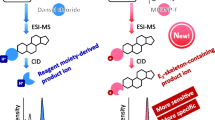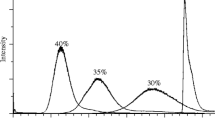Abstract
17β-Estradiol (17β-E2) is a steroid with pleiotropic actions. In addition to being a sexual hormone, it is also produced in the brain where it modulates the reproductive axis. It has been shown that 17β-E2 also acts on synaptic plasticity and plays a role in neurological pathways and in neurodegenerative diseases. Assaying this steroid in the brain is thus interesting to improve our knowledge of 17β-E2 effects in the brain. However, 17β-E2 concentration in the central nervous system has been reported to be of a few nanograms per gram wet weight (nanomolar range concentration); therefore, its quantification requires both an efficient extraction process and a sensitive detection method. Herein is presented a derivatization-free procedure based on solid-phase extraction followed by LC-MS/MS analysis, targeted on 17β-E2, its isomer17α-E2, and its metabolites estrone (E1) and estriol (E3). This extraction process allowed reaching 96% 17β-E2 recovery from the mouse brain. Limit of detection (LOD) and limit of quantification (LOQ) values of 0.5 and 2.5 pmol mL−1, respectively, were reached for both 17α-E2 and 17β-E2. LOD values for E1 and E3 were 0.01 and 0.025 pmol mL−1, respectively. The variation coefficients for intra- and inter-assays were 6 and 14%, respectively, for both estradiol forms. The method was applied to assess estrogen levels in the mouse brain and hippocampus after 17β-E2 acute (subcutaneous injection) and chronic (drinking water) physiological administration. Total estrogen levels were determined after enzymatic deconjugation and compared to free estrogen levels. While 17α-E2 was not detected in biological samples, 17β-E2 and metabolite measurements highlight a local biotransformation of estrogens after physiological administration via drinking water.

Method workflow: After oral or subcutaneous Estradiol administration, mouse brain or hippocampus was removed. Samples were homogenized and prepared according to a liquid-liquid extraction, followed by a solid-phase extraction. Then, LC-MS/MS was optimized to quantify 17ß-E2, its isomer17α-E2, its metabolites estrone (E1) and estriol (E3) and their conjugates





Similar content being viewed by others
References
D’Agata R, Gulizia S, Ando S, Vitale G, Polosa P. Effect of oestradiol on gonadotrophin release induced by LHRH in men. Clin Endocrinol. 1976;5(4):393–7.
Batrinos ML. Premenopause: the endocrinology of reproductive decline. Hormones (Athens). 2013;12(3):334–49.
Carreau S, Bouraima-Lelong H, Delalande C. Estrogens: new players in spermatogenesis. Reprod Biol. 2011;11(3):174–93.
Joseph A, Shur BD, Ko C, Chambon P, Hess RA. Epididymal hypo-osmolality induces abnormal sperm morphology and function in the estrogen receptor alpha knockout mouse. Biol Reprod. 2010;82(5):958–67.
Turner KJ, Morley M, Atanassova N, Swanston ID, Sharpe RM. Effect of chronic administration of an aromatase inhibitor to adult male rats on pituitary and testicular function and fertility. J Endocrinol. 2000;164(2):225–38.
Galmiche G, Richard N, Corvaisier S, Kottler ML. The expression of aromatase in gonadotropes is regulated by estradiol and gonadotropin-releasing hormone in a manner that differs from the regulation of luteinizing hormone. Endocrinology. 2006;147(9):4234–44.
Compaan JC, Hutchison JB, Wozniak A, de Ruiter AJ, Koolhaas JM. Brain aromatase activity and plasma testosterone levels are elevated in aggressive male mice during early ontogeny. Brain Res Dev Brain Res. 1994;82(1–2):185–92.
Hao J, Rapp PR, Leffler AE, Leffler SR, Janssen WG, Lou W, et al. Estrogen alters spine number and morphology in prefrontal cortex of aged female rhesus monkeys. J Neurosci. 2006;26(9):2571–8.
Mukai H, Kimoto T, Hojo Y, Kawato S, Murakami G, Higo S, et al. Modulation of synaptic plasticity by brain estrogen in the hippocampus. Biochim Biophys Acta. 2010;1800(10):1030–44.
Rossetti MF, Cambiasso MJ, Holschbach MA, Cabrera R. Oestrogens and progestagens: synthesis and action in the brain. J Neuroendocrinol. 2016;28(7). doi:10.1111/jne.12402.
Azcoitia I, Santos-Galindo M, Arevalo MA, Garcia-Segura LM. Role of astroglia in the neuroplastic and neuroprotective actions of estradiol. Eur J Neurosci. 2010;32(12):1995–2002.
Mukai H, Tsurugizawa T, Murakami G, Kominami S, Ishii H, Ogiue-Ikeda M, et al. Rapid modulation of long-term depression and spinogenesis via synaptic estrogen receptors in hippocampal principal neurons. J Neurochem. 2007;100(4):950–67.
Murakami G, Hojo Y, Ogiue-Ikeda M, Mukai H, Chambon P, Nakajima K, et al. Estrogen receptor KO mice study on rapid modulation of spines and long-term depression in the hippocampus. Brain Res. 2015;1621:133–46.
Bian C, Zhu H, Zhao Y, Cai W, Zhang J. Intriguing roles of hippocampus-synthesized 17beta-estradiol in the modulation of hippocampal synaptic plasticity. J Mol Neurosci. 2014;54(2):271–81.
Caruso D, Scurati S, Maschi O, De Angelis L, Roglio I, Giatti S, et al. Evaluation of neuroactive steroid levels by liquid chromatography-tandem mass spectrometry in central and peripheral nervous system: effect of diabetes. Neurochem Int. 2008;52(4–5):560–8.
Caruso D, Pesaresi M, Abbiati F, Calabrese D, Giatti S, Garcia-Segura LM, et al. Comparison of plasma and cerebrospinal fluid levels of neuroactive steroids with their brain, spinal cord and peripheral nerve levels in male and female rats. Psychoneuroendocrinology. 2013;38(10):2278–90.
Lopez-Rodriguez AB, Acaz-Fonseca E, Giatti S, Caruso D, Viveros M-P, Melcangi RC, et al. Correlation of brain levels of progesterone and dehydroepiandrosterone with neurological recovery after traumatic brain injury in female mice. Psychoneuroendocrinology. 2015;56:1–11.
Ooishi Y, Kawato S, Hojo Y, Hatanaka Y, Higo S, Murakami G, et al. Modulation of synaptic plasticity in the hippocampus by hippocampus-derived estrogen and androgen. J Steroid Biochem Mol Biol. 2012;131(1–2):37–51.
Hojo Y, Higo S, Ishii H, Ooishi Y, Mukai H, Murakami G, et al. Comparison between hippocampus-synthesized and circulation-derived sex steroids in the hippocampus. Endocrinology. 2009;150(11):5106–12.
Azcoitia I, Yague JG, Garcia-Segura LM. Estradiol synthesis within the human brain. Neuroscience. 2011;191(139–47):1010–6.
Sorwell KG, Urbanski HF. Causes and consequences of age-related steroid hormone changes: insights gained from nonhuman primates. J Neuroendocrinol. 2013;25(11):1062–9.
Kushnir MM, Rockwood AL, Bergquist J, Varshavsky M, Roberts WL, Yue B, et al. High-sensitivity tandem mass spectrometry assay for serum estrone and estradiol. Am J Clin Pathol. 2008;129(4):530–9.
Zacharia LC, Dubey RK, Jackson EK. A gas chromatography/mass spectrometry assay to measure estradiol, catecholestradiols, and methoxyestradiols in plasma. Steroids. 2004;69(4):255–61.
Abdel-Khalik J, Bjorklund E, Hansen M. Simultaneous determination of endogenous steroid hormones in human and animal plasma and serum by liquid or gas chromatography coupled to tandem mass spectrometry. J Chromatogr B Analyt Technol Biomed Life Sci. 2013;928(58–77):1010–6.
Pouech C, Tournier M, Quignot N, Kiss A, Wiest L, Lafay F, et al. Multi-residue analysis of free and conjugated hormones and endocrine disruptors in rat testis by QuEChERS-based extraction and LC-MS/MS. Anal Bioanal Chem. 2012;402(9):2777–88.
Hosogi J, Tanaka H, Fujita K, Kuwabara T, Ikegawa S, Kobayashi N, et al. LC-MS/MS coupled with immunoaffinity extraction for determination of estrone, 17beta-estradiol and estrone 3-sulfate in human plasma. J Chromatogr B. 2010;878(2):222–7.
Fiers T, Casetta B, Bernaert B, Vandersypt E, Debock M, Kaufman JM. Development of a highly sensitive method for the quantification of estrone and estradiol in serum by liquid chromatography tandem mass spectrometry without derivatization. J Chromatogr B. 2012;893-894(57–62):1010–6.
McNamara KM, Harwood DT, Simanainen U, Walters KA, Jimenez M, Handelsman DJ. Measurement of sex steroids in murine blood and reproductive tissues by liquid chromatography-tandem mass spectrometry. J Steroid Biochem Mol Biol. 2010;121(3–5):611–8.
Nguyen HP, Li L, Gatson JW, Maass D, Wigginton JG, Simpkins JW, et al. Simultaneous quantification of four native estrogen hormones at trace levels in human cerebrospinal fluid using liquid chromatography-tandem mass spectrometry. J Pharm Biomed Anal. 2011;54(4):830–7.
Labrie F. All sex steroids are made intracellularly in peripheral tissues by the mechanisms of intracrinology after menopause. J Steroid Biochem Mol Biol. 2015;145:133–8.
Fernandez SM, Frick KM. Chronic oral estrogen affects memory and neurochemistry in middle-aged female mice. Behav Neurosci. 2004;118(6):1340–51.
Meng FT, Zhao J, Ni RJ, Fang H, Zhang LF, Zhang Z, et al. Beneficial effects of enriched environment on behaviors were correlated with decreased estrogen and increased BDNF in the hippocampus of male mice. Neuro Endocrinol Lett. 2015;36(5):490–7.
Mitra S, Chakrabarti N, Dutta SS, Ray S, Bhattacharya P, Sinha P, et al. Gender-specific brain regional variation of neurons, endogenous estrogen, neuroinflammation and glial cells during rotenone-induced mouse model of Parkinson’s disease. Neuroscience. 2015;292:46–70.
Acknowledgments
The authors would like to thank the financial support of Erasmus Program for a research grant for EL, the Fondation pour la Recherche Médicale (Paris France), the IBiSA platform network, and Aquitaine Regional Government for the financial support for the mass spectrometry equipment and for the “Nouvelle Equipe Neurocampus.” The author would like to thank Dr. Boutayna Rourrhi-Frih for her discussion on SPE with EL.
Author information
Authors and Affiliations
Corresponding author
Ethics declarations
Conflict of interest
The authors declare that they have no conflict of interest.
Research involving human participants and/or animals
All animal care and samples withdrawn were conducted in compliance with the European Communities Council Directive 2010-63-EU and approved by the Bordeaux University Animal Care and Use Committee under the protocol number 5012041. All efforts were made to minimize animal suffering, to reduce the number of animals, and to utilize alternatives to in vivo techniques, if available.
Electronic supplementary material
ESM 1
(PDF 5.48 mb)
Rights and permissions
About this article
Cite this article
Lozan, E., Shinkaruk, S., Al Abed, S.A. et al. Derivatization-free LC-MS/MS method for estrogen quantification in mouse brain highlights a local metabolic regulation after oral versus subcutaneous administration. Anal Bioanal Chem 409, 5279–5289 (2017). https://doi.org/10.1007/s00216-017-0473-9
Received:
Revised:
Accepted:
Published:
Issue Date:
DOI: https://doi.org/10.1007/s00216-017-0473-9




